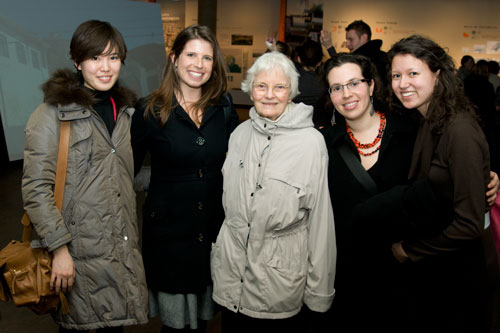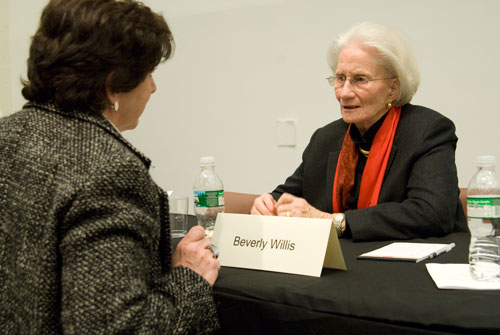Student Activism: Women in Design
As Caroline James MArch ’14 told Architectural Record this spring, “I was having a discussion with one of my classmates, Mia Scharphie MLA ’13. Sheryl Sandberg’s book Lean In had just come out. We were casually discussing how women in our school tend to speak up less in class. Around the same time—completely coincidentally—Billie Tsien and Tod Williams were coming to the GSD as senior Loeb Fellows.” Asked to organize a group of women to host a breakfast with Tsien, James and Scharphie decided to re-launch the dormant student group, Women in Design (WiD), by branding the breakfast as a WiD event.
As Arielle Assouline-Lichten MArch ’13 recalls, “A few days after the breakfast, I was reading a blog post about Denise Scott Brown and the lunch for the Architects’ Journal in London. I felt strongly that somebody needed to do something to create a platform for support. I realized there needed to be an outlet for the design community to voice (their convictions) to the Pritzker committee.” Assouline-Lichten rocketed to action – on March 27, 2013, Assouline-Lichten and James penned a petition on Change.org in pursuit of retroactive recognition for Denise Scott Brown’s role in the 1991 Pritzker Prize awarded to her husband and partner, Robert Venturi. “And we just started emailing everybody that we could find. WiD acts as a platform for getting the petition to a broader audience because it comes from Harvard. Many of our professors have circulated the petition as well.”
The petition garnered a media maelstrom, including articles in the New York Times, New Yorker, New York Magazine, Architectural Record, Huffington Post and Arch Daily. Since its creation, the petition has received over 18,000 signatures, including GSD Dean Mohsen Mostafavi and both past and present GSD faculty members. As reported in the New York Times, Dean Mostafavi applauded the students’ efforts, “The initiative on the part of the students is something that I really value. I hope they will be this proactive when it comes to their own futures.”
Despite the negative response from the Pritzker Jury Chair Lord Peter Palumbo, the petition has had real impact. The AIA Board of Directors voted to revise eligibility for the AIA Gold Medal to include “two individuals working together.” The change in AIA policy reflects the shifting tide inspired by the controversy, and recognizes the collaborative nature of architecture and design. Committed to the fight, WiD published a July 11 response to Pritzker, expressing their disappointment in the jury’s decision to not reconsider the award, warning of “prolonging the myth of the lone male hero in architecture.” Taking note of the success of the petition, Katy Barkan, a former WiD co-chair and current GSD faculty member, remarked, “It’s great to see the way WiD has struck a chord and built consensus in the larger community. I commend them for pressing on and making noise.”

Capping two previous surges in activity, the work of today’s WiD student group might be aptly called version 3.0. While the documentation is sparse, the history of WiD weaves a compelling tale, shrouded in mystery. The mostly oral history reveals swells of activism reflecting the interests and passions of each new cohort of students. Consensus is that Judith DeJong MAUD ’01 founded this iteration of the student group at the GSD in the fall semester of 2000. DeJong, now a professor at the University of Illinois in Chicago, recalls, “The general goals were to highlight the achievements of women in design, and to develop a network of professional and social support for women at the GSD.”
In 2005, the group, led by then president Laura Crescimano MArch ’06, galvanized around a symposium called “Taking Stock: Gender and Design” that explored the status of women in design fields. GSD faculty, supportive of the group over the years, participated in a two-hour panel discussion on gender issues that packed Piper Auditorium. According to Professor in the Practice of Architecture Toshiko Mori, an informal advisor to today’s group, faculty support has been a constant–Monica Ponce de Leon, Sarah Whiting, Ines Laumiere and Sarah Goldhagen all provided council during their tenures at the GSD.
In 2008, co-led by Katy Barkan, Jayne Kang MArch ’10, and Emily Pearl MArch ’09, WiD organized an ambitious four-day program that spanned the course of a month entitled “Progress in Process,” hosting 18 speakers for candid conversations on topics including partnerships, women’s roles internationally, and women’s larger role in society. They mounted an extensive exhibition documenting the changing role of women at the GSD, mapping the whereabouts of almost 500 graduates, and highlighting the dearth of female practitioners. Review An Oral History: WiD’s Leadership Timelinefor information about past leadership.

While both previous symposiums sited gender statistics related to the design professions, these stats are difficult to come by. The National Architectural Accrediting Board reported in 2009 that 41% of US architecture graduates were women while the AIA National Associates Committee Report from 2004 reports that only 20% of licensed architects are women. WiD, with the support of the Dean, hopes to foster change. Today, the GSD student body achieves near perfect gender equality, but the percentage of female faculty, teaching assistants, studio jurors and licensed practitioners struggles to keep pace. That said, there is measurable progress within the school – the number of tenured faculty who are women has increased significantly over the past decade, from about 12.5% in 2004 to just over 25% for this academic year.
Assouline-Lichten is encouraged by WiD’s impact, “That scenario will not happen again. It is forever marked that the bias is not okay.” Despite leaving Cambridge in June to start a small multi-disciplinary design firm in Brooklyn with her boyfriend and fellow GSD alum, Ben Brady MArch ’12, she feels an implicit responsibility to push the petition cause forward. For the current academic year, James is joined by Patricia Semmler MArch ’15 in co-chairing WiD with support from student and faculty representatives from all departments at the GSD. In addition to building university-wide alliances and bolstering engagement within the school, WiD is organizing a panel entitled “Partners in Crime.” The conference, building on Scott Brown’s own ambitions to create an institute dedicated to the process of “collaboration in design,” will host pairs of famous collaborators who work in equal partnerships. The objective is “to illuminate the diversity in collaborative efforts.”
James encourages students and alumni to join the Women in Design LinkedIn Group and to visit the new website, Design for Equality, “that will continue to build upon our work and be a forum for our collaborators.” Above all, WiD is thrilled to help welcome Denise Scott Brown to Piper Auditorium on October 22, 2013. During the Progress in Process symposium in 2008, a student asked, “Why is it so important for students to engage in this debate?” Scott Brown is said to have sagely proclaimed, “Because otherwise, we end up taking it personally.”
All photos courtesy of Caroline James

